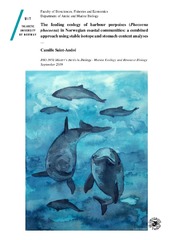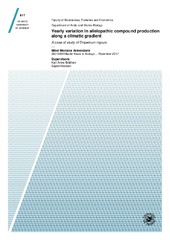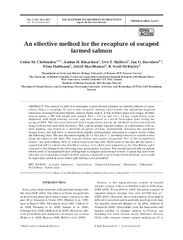Institutt for arktisk og marin biologi: Nye registreringer
Viser treff 1201-1220 av 2086
-
Identification of evolutionary and kinetic drivers of NAD-dependent signaling
(Journal article; Tidsskriftartikkel; Peer reviewed, 2019-07-24)Nicotinamide adenine dinucleotide (NAD) is best known as an essential cofactor of biochemical reactions. In addition, it is involved in the regulation of virtually all major cellular events. These NAD-dependent regulatory functions are mediated by enzymes (e.g., sirtuins, poly–adenosine -diphosphate [ADP] ribose polymerases, ADP-ribosyl cyclases) that cleave the molecule to liberate nicotinamide ... -
Life cycle assessment of recirculating aquaculture systems: A case of Atlantic salmon farming in China
(Journal article; Tidsskriftartikkel; Peer reviewed, 2019-04-01)Recirculating aquaculture systems (RAS) are an alternative technology to tackle the major environmental challenges associated with conventional cage culture systems. In order to systematically assess the environmental performance of RAS farming, it is important to take the whole life cycle into account so as to avoid ad hoc and suboptimal environmental measures. So far, the application of life cycle ... -
Implications of Coastal Darkening for Contaminant Transport, Bioavailability, and Trophic Transfer in Northern Coastal Waters
(Journal article; Tidsskriftartikkel; Peer reviewed, 2019-06-13)The increased transport of terrestrially derived organic material (tOM) from catchments to rivers and lakes is leading to browning of northern freshwaters.(1) Although the same environmental drivers can be expected to lead to widespread increases in tOM and subsequent darkening in adjacent coastal systems,(2) this has received considerably less attention, and long-term monitoring data for detecting ... -
Increased occurrence of the jellyfish Periphylla periphylla in the European high Arctic
(Journal article; Tidsskriftartikkel; Peer reviewed, 2018-06-25)The jellyfish <i>Periphylla periphylla</i>, which can have strong ecological impacts on its environment, is ubiquitous in the Norwegian Sea and its range was predicted to extend northwards. The occurrence of <i>P. periphylla</i> in the northern Barents Sea increased since 2014 and, for the first time, several individuals were collected within a high Arctic fjord (> 78°N) in western Spitsbergen in ... -
Seasonal and spatial variations in biomarker baseline levels within Arctic populations of mussels (Mytilus spp.)
(Journal article; Tidsskriftartikkel; Peer reviewed, 2018-11-28)Climate change and pollution resulting from human activities in the Arctic require reliable monitoring systems in sentinel species. Mytilus spp. are used as sentinel species all around the world. The use of Mytilus spp. in environmental monitoring requires knowledge about natural variations in pollution biomarkers. Seasonal variations in baseline levels of biomarkers were studied over a year in the ... -
The feeding ecology of harbour porpoises (Phocoena phocoena) in Norwegian coastal communities: a combined approach using stable isotope and stomach content analyses
(Master thesis; Mastergradsoppgave, 2019-09-20)The harbour porpoise is a key predator in Norwegian coastal communities, therefore studying its feeding ecology is important to understand its ecological role and may shed light on the dynamics of Norwegian coastal ecosystems. The diet of 134 harbour porpoises bycaught in Autumn 2016 (n = 61) and Spring 2017 (n = 73) in Norwegian coastal waters and fjords was investigated using both stable isotopes ... -
Towards a global arctic-alpine model for Near-infrared reflectance spectroscopy (NIRS) predictions of foliar nitrogen, phosphorus and carbon content
(Journal article; Tidsskriftartikkel; Peer reviewed, 2019-06-04)Near-infrared spectroscopy (NIRS) is a high-throughput technology with potential to infer nitrogen (N), phosphorus (P) and carbon (C) content of all vascular plants based on empirical calibrations with chemical analysis, but is currently limited to the sample populations upon which it is based. Here we provide a first step towards a global arctic-alpine NIRS model of foliar N, P and C content. We ... -
Effect of Antiviral Drugs against Cervid Herpesvirus 2 (CvHV2) in vitro
(Master thesis; Mastergradsoppgave, 2018-11-15)Cervid herpesvirus 2 (CvHV2) is an alphaherpesvirus found in Rangifer subspecies throughout most of the circumpolar Arctic and the causative agent of infectious keratoconjunctivitis (IKC) in semi-domesticated Eurasian tundra reindeer (Rangifer tarandus tarandus). IKC occurs as regular outbreaks, affecting dozens of reindeer in a herd, and is most common and severe among calves and young animals. IKC ... -
Yearly variation in allelopathic compound production along a climatic gradient. A case of study of Empetrum nigrum
(Master thesis; Mastergradsoppgave, 2017-11-15)Empetrum nigrum is a plant common in northern ecosystems with capacity to produce allelopathic compounds, which among other effects inhibit seed establishment and germination of other plants. Some of the most studied compounds regarding this effect are batatasin-III and phenolic acids, among them caffeic acid, which account for a large proportion of the leaf’s biomass. 5 random sites were established ... -
Long-term ecological studies in northern lakes – challenges, experiences, and accomplishments
(Journal article; Tidsskriftartikkel; Peer reviewed, 2018-08-15)We review three long‐term research programs performed over the last four decades on the ecology and management of oligotrophic lake systems with different fish communities at 69° N in Norway. Through whole‐lake perturbation experiments, intensive culling of stunted fish removed 35 tons (1984–1991) of Arctic charr <i>Salvelinus alpinus</i> in Takvatn (15 km<sup>2</sup>) and 153 tons (1981–1983, ... -
Populasjonssykluser hos bjørkemålere – små dyr med enorme svingninger
(Journal article; Tidsskriftartikkel; Peer reviewed, 2019-06-27)Fjellbjørkemåler og liten frostmåler er to nattsommerfugler som har sykliske populasjonssvingninger i fjellbjørkeskogen i Skandinavia. Populasjonstopper kommer med omtrent ti års mellomrom, og tettheten av målere i toppår kan være flere tusen ganger høyere enn i bunnår. Selv om syklusene er godt beskrevet ved hjelp av lange tidsserier er årsaken til svingningene dårlig forstått. Antibeitestoffer hos ... -
Earlier colony arrival but no trend in hatching timing in two congeneric seabirds (Uria spp.) across the North Atlantic
(Journal article; Tidsskriftartikkel; Peer reviewed, 2019-10-23)A global analysis recently showed that seabird breeding phenology (as the timing of egg-laying and hatching) does not, on average, respond to temperature changes or advance with time (Keogan <i>et al.</i> 2018 <i>Nat. Clim. Change</i> <b>8</b>, 313–318). This group, the most threatened of all birds, is therefore prone to spatio-temporal mismatches with their food resources. Yet, other aspects of ... -
An effective method for the recapture of escaped farmed salmon
(Journal article; Tidsskriftartikkel; Peer reviewed, 2011-04-04)The search for effective strategies to prevent and mitigate accidental releases of aquaculture fishes is on-going. To test a new recapture strategy and evaluate the individual dispersal behaviour of escaped farmed Atlantic salmon <i>Salmo salar</i> L. at the northern limit of its range, 39 adult salmon (mean ± SD fork length and weight: 85.5 ± 5.0 cm and 7.4 ± 1.4 kg, respectively) were implanted ... -
Resource polymorphism in European whitefish: Analysis of fatty acid profiles provides more detailed evidence than traditional methods alone
(Journal article; Peer reviewed, 2019-08-20)Resource polymorphism—whereby ancestral generalist populations give rise to several specialised morphs along a resource gradient—is common where species colonise newly formed ecosystems. This phenomenon is particularly well documented in freshwater fish populations inhabiting postglacial lakes formed at the end of the last ice age.<br> However, knowledge on how such differential exploitation of ... -
Ocean predation and mortality of adult Atlantic salmon
(Journal article; Peer reviewed, 2019-05-27)Predation and mortality are often difficult to estimate in the ocean, which hampers the management and conservation of marine fishes. <br>We used data from pop-up satellite archival tags to investigate the ocean predation and mortality of adult Atlantic salmon (Salmo salar) released from 12 rivers flowing into the North Atlantic Ocean. Data from 156 tagged fish revealed 22 definite predation ... -
Diversity and Distribution of Meroplanktonic Larvae in the Pacific Arctic and Connectivity With Adult Benthic Invertebrate Communities
(Journal article; Tidsskriftartikkel; Peer reviewed, 2019-08-13)Pelagic larval stages (meroplankton) of benthic invertebrates seasonally make up a significant proportion of planktonic communities, as well as determine the distribution of their benthic adult stages, yet are frequently overlooked by both plankton and benthic studies. Within the Arctic, the role of meroplanktonic larvae may be particularly important in regions of inflow from sub-Arctic regions, ... -
Recolonization and succession of a subtidal hard-bottom epibenthic community in Smeerenburgfjorden, NW Svalbard.
(Master thesis; Mastergradsoppgave, 2018-05-15)Rapid changes to the physical environment of Arctic marine systems in recent years impact the structure and function of benthic ecosystems. Exploring the resilience of these systems to perturbations requires a solid understanding of key ecological processes and must be conducted over appropriate time scales due to the slow growth and recruitment of many Arctic benthic organisms. This study addresses ... -
The role of gill raker number variability in adaptive radiation of coregonid fish
(Journal article; Tidsskriftartikkel; Peer reviewed, 2010-07-27)Gill raker divergence is a general pattern in adaptive radiations of postglacial fish, but few studies have addressed the adaptive significance of this morphological trait in foraging and eco-evolutionary interactions among predator and prey. Here, a set of subarctic lakes along a diversifying gradient of coregonids was used as the natural setting to explore correlations between gill raker numbers ... -
Prevalence of antibodies against Brucella spp. in West Greenland polar bears (Ursus maritimus) and East Greenland muskoxen (Ovibos moschatus)
(Journal article; Tidsskriftartikkel; Peer reviewed, 2018-03-19)Zoonotic infections transmitted from terrestrial and marine mammals to humans in European Arctic are of unknown significance, despite considerable potential for transmission due to local hunt and a rapidly changing environment. As an example, infection with <i>Brucella</i> bacteria may have significant impact on human health due to consumption of raw meat or otherwise contact with tissues and fluids ... -
Arctic marine fungi: biomass, functional genes, and putative ecological roles
(Journal article; Peer reviewed, 2019-02-11)Recent molecular evidence suggests a global distribution of marine fungi; however, the ecological relevance and corresponding biological contributions of fungi to marine ecosystems remains largely unknown. We assessed fungal biomass from the open Arctic Ocean by applying novel biomass conversion factors from cultured isolates to environmental sterol and CARD-FISH data. <br>We found an average of ...


 English
English norsk
norsk


















